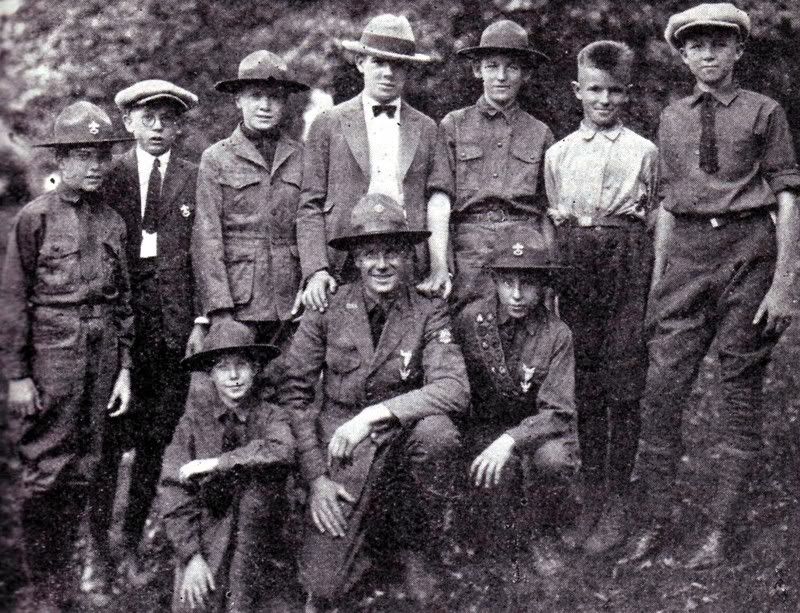Rain fell over northern Utah all afternoon on Aug. 13, 1923, but life went on. Mary Ward settled into her son’s Willard home, having arrived only the day before. Almost 500 tourists enjoyed the midway at Lagoon. Even campers carried out their plans – Mr. and Mrs. W.J. Wright of Ogden, married less than a year after meeting as missionaries in Hawaii, pitched a tent up North Fork Canyon for a delayed honeymoon. Four boys from Salt Lake made a camp in Farmington Canyon, and just over the hill from them nine Scouts led by George Bergstrom readied their six tents for a wet night.
Well after dark, the Scouts were settled into a single tent listening to a ghost story. The rain stopped abruptly, and in the sudden silence from the skies the boys heard the thundering sound of a flash flood. Before they could move, a wall of water swept them and their tent into a deep torrent dozens of yards wide.
In the overgrazed hills of Utah there was almost nothing to hold back the rain that night. At about the same time the Scouts were washed away, flash floods in Salt Lake’s Avenues swept so much gravel downhill that tracks were buried and the streetcar system came to a halt. Adobe homes in Farmington crumbled into mud, and brick homes were buried to their roof lines. More than half the town of Willard disappeared, huge boulders from the mountains above marking the lots where buildings had been.
Three feet of water covered Lagoon, its patrons marooned in a shrinking island of high ground until a rescue train from Salt Lake inched toward the resort and carried them to safety. The tent housing an employee’s family disappeared in muddy water; the employee saved most of his family, then died of a heart attack. A hero rose from his sickbed to plunge into the creek there to save a 2-year-old girl and an 80-year-old woman.
The honeymooning Wrights and the four boy campers – two of them brothers, the only children of a widowed mother – didn’t have a chance. Their battered bodies were eventually found miles downstream. Mrs. Ward drowned at Willard, with her daughter-in-law; her 11-year-old granddaughter was pulled from the mud and revived.
Bergstrom’s Scouts were separated, but managed to cling to trees or debris. Gradually they pulled themselves hand over hand until most were in a single group, still surrounded by the flood. Only Bergstrom’s son Clyde was missing. Receiving no response to repeated calls, the desperate father let go of his anchoring brush and let the flood carry him hundreds of yards downstream, where he washed up against the same wreckage that trapped Clyde, his face barely above water. Father disentangled son, and the pair battled the current to return to the other boys, and to their camp cook and his wife.
 Cold, barefoot, plastered with mud, and most of them nude or clad only in underwear, the Scouts fought their way to their car. The engine caught, but the wheels were fast in mud. They used gasoline to saturate already-soaked debris, coaxed sparks from a battery, and warmed themselves by the resulting fire. When dawn came, Bergstrom hiked to the highway and found a farmhouse, whose occupants responded with blankets and coats and hot food, and a team of horses to pull the car from the mud. Only after they reached home did grateful parents learn that their boys were alive.
Cold, barefoot, plastered with mud, and most of them nude or clad only in underwear, the Scouts fought their way to their car. The engine caught, but the wheels were fast in mud. They used gasoline to saturate already-soaked debris, coaxed sparks from a battery, and warmed themselves by the resulting fire. When dawn came, Bergstrom hiked to the highway and found a farmhouse, whose occupants responded with blankets and coats and hot food, and a team of horses to pull the car from the mud. Only after they reached home did grateful parents learn that their boys were alive.
At least 11 Utahns perished in that flood of 85 years ago, and hundreds of thousands of dollars of property was lost. In a direct response to the losses that night, scientists studied Utah’s flood paths, pinning the blame on eroded hillsides. More losses occurred in more floods before corrective steps were taken, but concentrated efforts to rehabilitate Utah’s hillsides during the 1930s ended Utah’s regular devastation by flash floods.
(Photo: The Boy Scouts who survived the 1923 Willard Flood were, front from left, Clyde Bergstrom, George Bergstrom and Lorin Wheelwright; and back from left, James Niel, Howard Alvord, Ambrose Merrill Jr., Ben Wright, Fred Taylor Jr., Donald Foutz and Francis Simmerson.)
Continue reading at the original source →



